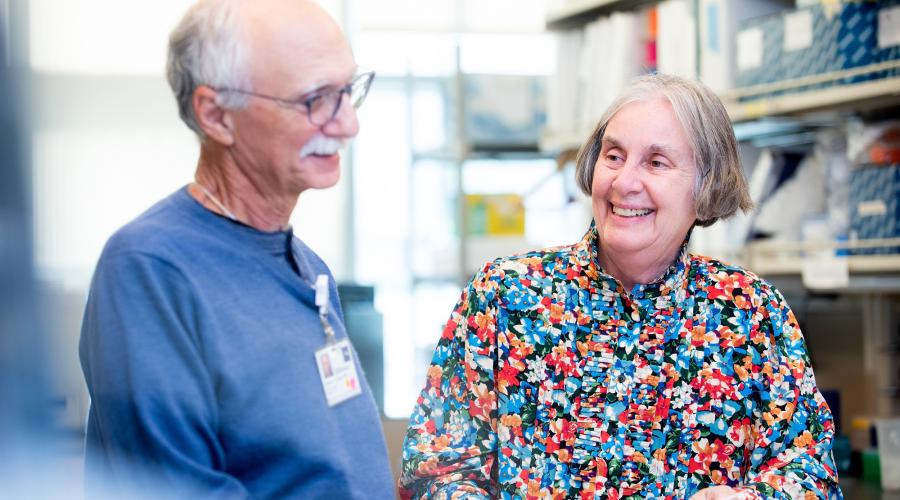
The Long Road to Gene Therapy for Immunodeficient Children
Thanks to nearly 30 years of research and effort, another groundbreaking discovery has improved treatment for one of the most devastating genetic disorders affecting young children today.
Two renowned UCSF Department of Pediatrics researchers in the Division of Allergy, Immunology and Bone Marrow Transplantation, Jennifer Puck, MD, and Mort Cowan, MD, have been pioneering research to help children born without functioning immune systems. Severe combined immunodeficiency (SCID) is known most widely by its nickname, the ‘bubble baby’ disease. Children born with SCID lack the ability to fight infections and most die before age 1 unless their immunity can be restored, usually by a bone marrow transplant from a healthy donor, ideally a matched sibling.
This treatment, however, has not worked well for one genetic form of SCID, the form caused by defects in the Artemis gene. The breakthrough involves a new gene therapy treatment for Artemis-SCID that allows researchers to add back a correct copy of the gene to the patient’s own harvested blood-forming stem cells.
“Artemis-SCID is the most difficult form of SCID to treat with bone marrow transplants,” says Cowan. “Compared to other SCID genotypes, patients have more rejection, poorer immune reconstitution and increased rates of graft-versus-host disease. Gene therapy seemed like it could overcome these issues.”
While fewer than five children are diagnosed with the disease each year in the United States, one out of 2,000 Navajo births are affected. Puck spent two summers in medical school on the Navajo reservation, and Cowan has treated many Native Americans with SCID using standard bone marrow transplants. Over the past 30 years, they’ve dedicated themselves to improving lives affected by the disease.
Finding the Responsible Gene
Despite Artemis-SCID being very rare, Cowan has treated over 30 patients with the disease, and most of these patients were of Navajo or Apache Native American descent. Recognizing that their form of SCID had worse health outcomes than expected, he sought out the underlying cause of the disease in hopes to find better treatments.
After 20 years of searching for the responsible gene, in 2002 Cowan identified the genetic mutation in the Artemis gene in Navajo and Apache populations. Cowan and his team were then able to create a method to overcome the debilitating mutation, opening the door for a new gene therapy treatment for Artemis-SCID.
Discovering and Implementing Newborn Screening
While Cowan was searching for the genetic cause behind Artemis-SCID, Puck conducted an early trial of newborn screening for SCID in Navajo maternity hospitals.
“SCID is so rare that most pediatricians never see a case in their entire career,” says Puck. “And because affected infants appear healthy at first, population-based newborn screening seemed to be the only strategy to identify newborns with SCID so that treatment could be provided before the onset of infectious complications,” she added.
Puck’s methodology utilizing routinely collected dried blood spots to measure a marker of normal immune cell development proved effective. California implemented statewide newborn screening for SCID in 2010, and the Navajo Nation did the same in 2011, following Puck’s work there. Currently, all states in the USA and several countries have added SCID to their newborn screening programs.
Treatment of SCID, which was once uniformly fatal in the first year of life, has been transformed to give patients a 94% survival rate and frequent full immune reconstitution.
Cowan and Puck joined forces to improve the survival rates of Artemis-SCID.
A Groundbreaking Clinical Trial for Artemis-SCID
By combining Cowan’s research to discover and correct Artemis-SCID with Puck’s widespread newborn screening, the two experts have collaborated on a clinical trial using gene therapy to treat Artemis-SCID. They’ve already put 10 young children born with the disease on track for healthier lives.
Published in a Dec. 22, 2022 study in the New England Journal of Medicine, the early results from this phase I/II clinical trial have both researchers looking optimistically at the future.
“Although this trial is still ongoing, we have already found that the patients in our trial have had far better outcomes than we expected, and better immune reconstitution than patients receiving standard transplant therapy,” says Puck.
“I’ve never seen results like this in Artemis-SCID before. It’s amazing,” says Cowan. “Our hope is to continue to offer this treatment to any child with Artemis-SCID. In a new pivotal trial, UCSF will be the processing facility and patients will be able to be treated at several medical centers around the United States.”
While the new gene therapy technique only requires a quarter of the chemotherapy needed for standard bone marrow transplants, Cowan and Puck believe that in the future they can further improve the treatment by implementing new targeted non-chemotherapy agents to make space for the gene-corrected cells in patients’ bone marrow. Despite already saving many children with SCID, they’re still pushing forward to improve health outcomes around the world.
Read More About Cowan and Puck’s Work Here
How Gene Therapy Saved a Child from “Bubble Boy Disease”
Infant Gene Therapy is a Breakthrough for Artemis-SCID Patients
